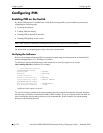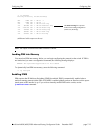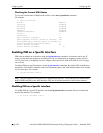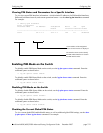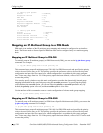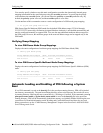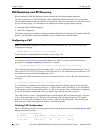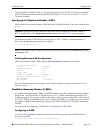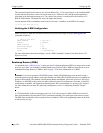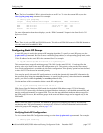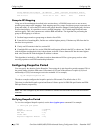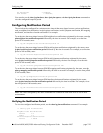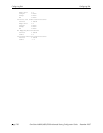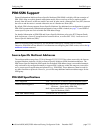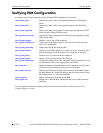
Configuring PIM Configuring PIM
page 7-26 OmniSwitch 6800/6850/9000 Advanced Routing Configuration Guide December 2007
This command specifies the router to use its local address 50.1.1.1 for advertising it as the candidate-BSR
for that domain, the priority value of the local router as a C-BSR to be 100, and the mask-length that is
advertised in the bootstrap messages as 4. The value of the priority is considered for the selection of C-
BSR for PIM domain. The higher the value, the higher the priority.
Use the no form of this command to remove the local routers’ candidacy as the BSR. For example:
-> no ip pim cbsr 50.1.1.1
Verifying the C-BSR Configuration
Note. Check the C-BSR and information about priority and mask-length using the show ip pim cbsr
command as follows:
-> show ip pim cbsr
CBSR Address = 214.0.0.7,
Status = enabled,
CBSR Priority = 0,
Hash Mask Length = 30,
Elected BSR = False,
Timer = 00h:00m:00s
For more information about these displays, see the “PIM Commands” chapter in the OmniSwitch CLI
Reference Guide.
Bootstrap Routers (BSRs)
As described in the “PIM Overview” section, the role of a Bootstrap Router (BSR) is to keep routers in the
network “up to date” on reachable Candidate Rendezvous Points (C-RPs). BSRs are elected from a set of
Candidate Bootstrap Routers (C-BSRs). Refer to page 7-9 for more information on C-BSRs.
Reminder. For correct operation, all PIM-SM routers within a PIM-SM domain must be able to map a
particular multicast group address to the same Rendezvous Point (RP). PIM-SM provides two methods for
group-to-RP mapping. One method is the Bootstrap Router mechanism, which also involves C-RP adver-
tisements, as described in this section; the other method is static RP configuration. Note that, if static RP
configuration is enabled, the Bootstrap mechanism and C-RP advertisements are automatically disabled.
For more information on static RP status and configuration, refer to “Configuring Static RP Groups”
below.
A C-RP periodically sends out messages, known as C-RP advertisements. When a BSR receives one of
these advertisements, the associated C-RP is considered reachable (if a valid route to the network exists).
The BSR then periodically sends an updated list of reachable C-RPs to all neighboring routers in the form
of a Bootstrap message.



